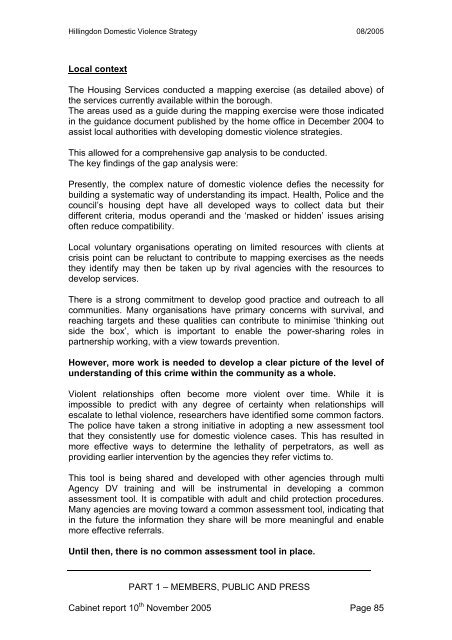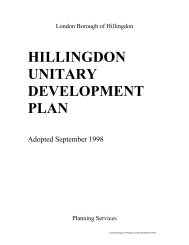Report - London Borough of Hillingdon
Report - London Borough of Hillingdon
Report - London Borough of Hillingdon
Create successful ePaper yourself
Turn your PDF publications into a flip-book with our unique Google optimized e-Paper software.
<strong>Hillingdon</strong> Domestic Violence Strategy 08/2005<br />
Local context<br />
The Housing Services conducted a mapping exercise (as detailed above) <strong>of</strong><br />
the services currently available within the borough.<br />
The areas used as a guide during the mapping exercise were those indicated<br />
in the guidance document published by the home <strong>of</strong>fice in December 2004 to<br />
assist local authorities with developing domestic violence strategies.<br />
This allowed for a comprehensive gap analysis to be conducted.<br />
The key findings <strong>of</strong> the gap analysis were:<br />
Presently, the complex nature <strong>of</strong> domestic violence defies the necessity for<br />
building a systematic way <strong>of</strong> understanding its impact. Health, Police and the<br />
council’s housing dept have all developed ways to collect data but their<br />
different criteria, modus operandi and the ‘masked or hidden’ issues arising<br />
<strong>of</strong>ten reduce compatibility.<br />
Local voluntary organisations operating on limited resources with clients at<br />
crisis point can be reluctant to contribute to mapping exercises as the needs<br />
they identify may then be taken up by rival agencies with the resources to<br />
develop services.<br />
There is a strong commitment to develop good practice and outreach to all<br />
communities. Many organisations have primary concerns with survival, and<br />
reaching targets and these qualities can contribute to minimise ‘thinking out<br />
side the box’, which is important to enable the power-sharing roles in<br />
partnership working, with a view towards prevention.<br />
However, more work is needed to develop a clear picture <strong>of</strong> the level <strong>of</strong><br />
understanding <strong>of</strong> this crime within the community as a whole.<br />
Violent relationships <strong>of</strong>ten become more violent over time. While it is<br />
impossible to predict with any degree <strong>of</strong> certainty when relationships will<br />
escalate to lethal violence, researchers have identified some common factors.<br />
The police have taken a strong initiative in adopting a new assessment tool<br />
that they consistently use for domestic violence cases. This has resulted in<br />
more effective ways to determine the lethality <strong>of</strong> perpetrators, as well as<br />
providing earlier intervention by the agencies they refer victims to.<br />
This tool is being shared and developed with other agencies through multi<br />
Agency DV training and will be instrumental in developing a common<br />
assessment tool. It is compatible with adult and child protection procedures.<br />
Many agencies are moving toward a common assessment tool, indicating that<br />
in the future the information they share will be more meaningful and enable<br />
more effective referrals.<br />
Until then, there is no common assessment tool in place.<br />
PART 1 – MEMBERS, PUBLIC AND PRESS<br />
Cabinet report 10 th November 2005 Page 85
















